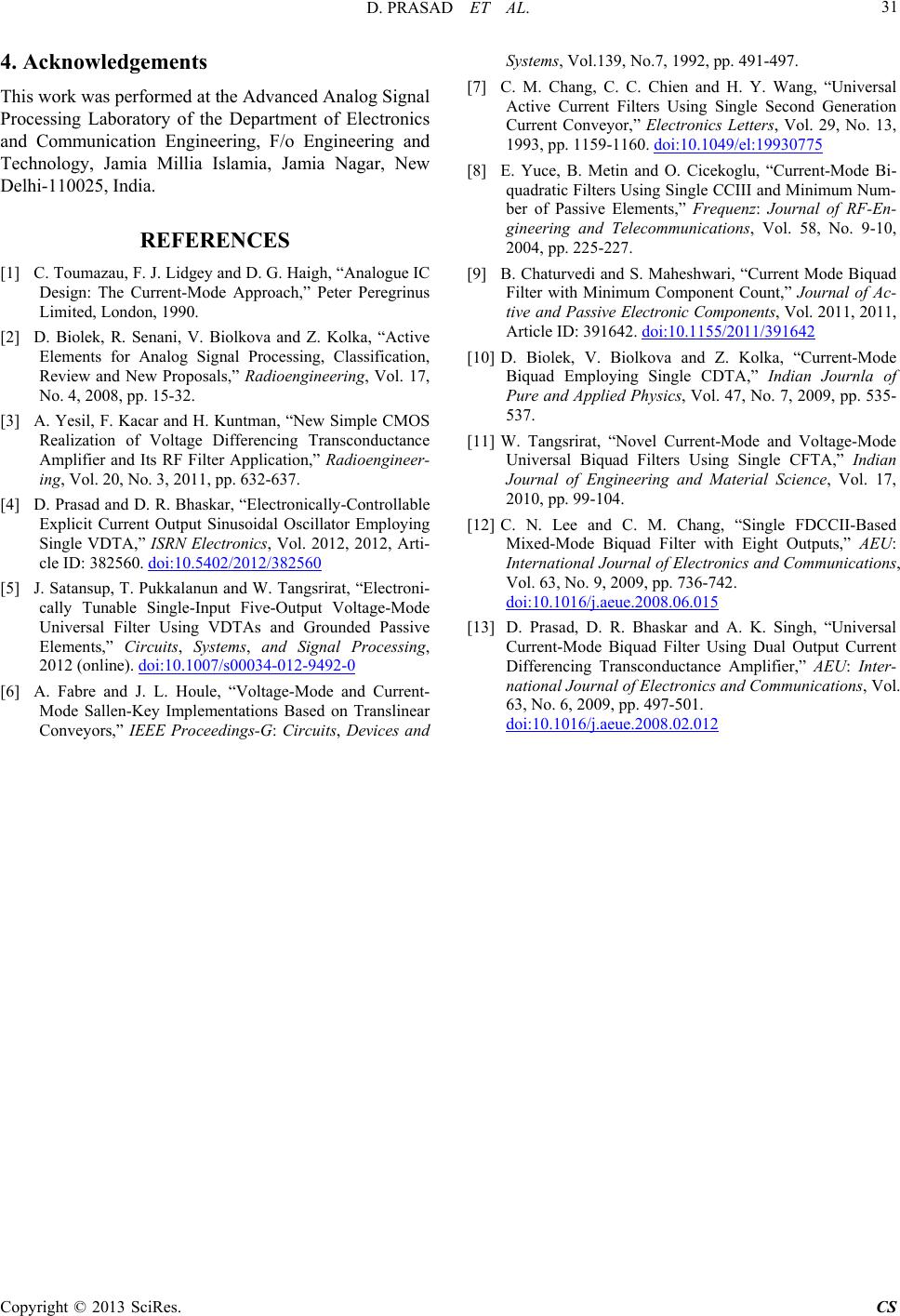
D. PRASAD ET AL.
Copyright © 2013 SciRes. CS
31
4. Acknowledgements
This work was performed at the Advanced Analog Signal
Processing Laboratory of the Department of Electronics
and Communication Engineering, F/o Engineering and
Technology, Jamia Millia Islamia, Jamia Nagar, New
Delhi-110025, India.
REFERENCES
[1] C. Toumazau, F. J. Lidgey and D. G. Haigh, “Analogue IC
Design: The Current-Mode Approach,” Peter Peregrinus
Limited, London, 1990.
[2] D. Biolek, R. Senani, V. Biolkova and Z. Kolka, “Active
Elements for Analog Signal Processing, Classification,
Review and New Proposals,” Radioengineering, Vol. 17,
No. 4, 2008, pp. 15-32.
[3] A. Yesil, F. Kacar and H. Kuntman, “New Simple CMOS
Realization of Voltage Differencing Transconductance
Amplifier and Its RF Filter Application,” Radioengineer-
ing, Vol. 20, No. 3, 2011, pp. 632-637.
[4] D. Prasad and D. R. Bhaskar, “Electronically-Controllable
Explicit Current Output Sinusoidal Oscillator Employing
Single VDTA,” ISRN Electronics, Vol. 2012, 2012, Arti-
cle ID: 382560. doi:10.5402/2012/382560
[5] J. Satansup, T. Pukkalanun and W. Tangsrirat, “Electroni-
cally Tunable Single-Input Five-Output Voltage-Mode
Universal Filter Using VDTAs and Grounded Passive
Elements,” Circuits, Systems, and Signal Processing,
2012 (online). doi:10.1007/s00034-012-9492-0
[6] A. Fabre and J. L. Houle, “Voltage-Mode and Current-
Mode Sallen-Key Implementations Based on Translinear
Conveyors,” IEEE Proceedings-G: Circuits, Devices and
Systems, Vol.139, No.7, 1992, pp. 491-497.
[7] C. M. Chang, C. C. Chien and H. Y. Wang, “Universal
Active Current Filters Using Single Second Generation
Current Conveyor,” Electronics Letters, Vol. 29, No. 13,
1993, pp. 1159-1160. doi:10.1049/el:19930775
[8] E. Yuce, B. Metin and O. Cicekoglu, “Current-Mode Bi-
quadratic Filters Using Single CCIII and Minimum Num-
ber of Passive Elements,” Frequenz: Journal of RF-En-
gineering and Telecommunications, Vol. 58, No. 9-10,
2004, pp. 225-227.
[9] B. Chaturvedi and S. Maheshwari, “Current Mode Biquad
Filter with Minimum Component Count,” Journal of Ac-
tive and Passive Electronic Components, Vol. 2011, 2011,
Article ID: 391642. doi:10.1155/2011/391642
[10] D. Biolek, V. Biolkova and Z. Kolka, “Current-Mode
Biquad Employing Single CDTA,” Indian Journla of
Pure and Applied Physics, Vol. 47, No. 7, 2009, pp. 535-
537.
[11] W. Tangsrirat, “Novel Current-Mode and Voltage-Mode
Universal Biquad Filters Using Single CFTA,” Indian
Journal of Engineering and Material Science, Vol. 17,
2010, pp. 99-104.
[12] C. N. Lee and C. M. Chang, “Single FDCCII-Based
Mixed-Mode Biquad Filter with Eight Outputs,” AEU:
International Journal of Electronics and Communications,
Vol. 63, No. 9, 2009, pp. 736-742.
doi:10.1016/j.aeue.2008.06.015
[13] D. Prasad, D. R. Bhaskar and A. K. Singh, “Universal
Current-Mode Biquad Filter Using Dual Output Current
Differencing Transconductance Amplifier,” AEU: Inter-
national Journal of Electronics and Communications, Vol.
63, No. 6, 2009, pp. 497-501.
doi:10.1016/j.aeue.2008.02.012